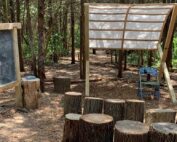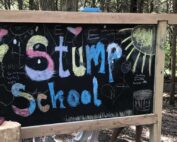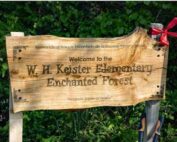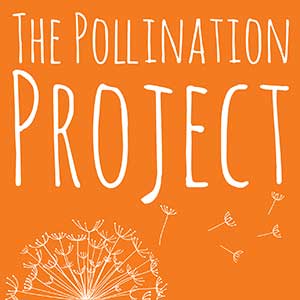Building a Student-Based Naturalist Collection
Suzanne E. Hiller
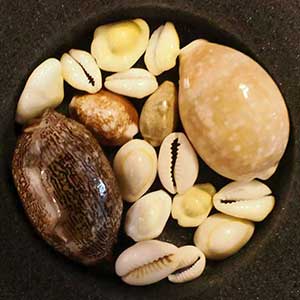
A collection of seashells from the Cypraeidae family, commonly known as cowries.
While there is growing evidence that outdoor learning is beneficial for students’ academic, physical, and social development, it is not always possible to teach on school grounds. Another way to bring the natural world to students is to use natural specimens as part of instruction for a variety of topics and subjects. These are objects commonly found in nature, like seashells, rocks and minerals, and seeds, as some examples.
Many educators have noted that natural specimens can be a valuable resource and display their personal collections in the classroom. Having a naturalist collection developed through a student-based naturalist club and as a school-wide resource can enhance the effectiveness of instruction, elevate student excitement for learning, and offer new avenues for creativity.
Even better, involving students in building, operating, and maintaining a naturalist collection as a club member can be an impactful opportunity. Learners are capable of participating in many tasks throughout the process while providing free loan resources to teachers and acknowledging their role in advancing the learning of their peers within the school community. At the same time, these students will learn about scientific topics in great detail as they conduct research to create a system, including the use of the Linnaean classification system, a system of organization developed by Carl Linnaeus, a Swedish botanist (Paterlini, 2007) and often used in museums of natural history.
Building a Naturalist Collection
One of the key aspects of engaging students in a naturalist club is that there are enough specimens, so that each student, or team of students, has a project that is their responsibility. Examples of projects would be having students organize seashells by families, sorting specimens by phylum, sorting sand by mineral composition, creating a set of woodland skulls (including ones made from 3-D printers), identifying fossils, making a set of different types of seeds, and flower presses. For this reason, it will be necessary to locate specimens to add to the collection.
Some possible ways to obtain natural objects would be to ask teachers, parents, administrators, and students to donate items in e-newsletters. It is advisable to state the types of natural objects that the students would like to obtain–the club sponsor should be aware that some items would not be appropriate. For instance, the U. S. Fish and Wildlife Service has strict guidelines prohibiting the collection of bird nests. Specific regions near the schools may have restrictions for collecting objects, which the club sponsor and students will want to research. Some students may find a natural object on their way to school and become very excited about adding the item to the collection. A turkey vulture leg – something once brought to my attention – would not be appropriate for the collection as it would rot!
As part of the club, students can be encouraged to scour the schoolyard and outdoor areas that they have access to as well. Donations are sometimes available through local master naturalist organizations. In addition, parent teacher organizations may have funding for these types of programs, so that students can order science department approved items.
Building a collection requires more than natural specimens. An assortment of boxes, foam, plastic bins, and tape will be necessary to organize and store items. Students may bring in small boxes they have at home to put under each object. Then the specimens are stored in a plastic bin and labeled. Once students have selected their specific project based on their interests, they determine which materials they will need to organize their assignment.
One of the more time intensive tasks of building the collection is researching the background information of the natural objects. Students can create cards to correspond with the objects to include in the sets (e.g., inventory, scientific names, form and function), so students and teachers in the school have background information. There should be directions for handling and storing the natural specimens to prevent damage. In addition, students can add the information about their project (e.g., the type of object, size, number in set) to a Google docs catalog, so that teachers can see what is available for loan. The students will want to develop a system for teachers to reserve items and a delivery and pick-up schedule will also be necessary. Responsible club members have the role of transporting the collection.
Maintaining the Collection
As teachers return the materials, students will want to analyze the contents and reorganize the kits if necessary. With loan collections, such as these, it is normal for wear and tear on objects. Students will need to be prepared that at times objects can be damaged unwittingly by other members of the school community. Reviewing the materials as they are returned is an important step in maintaining the collection as well as preparing the materials for the next instructor who schedules a loan. At this point, new specimens will also need to be gathered as students who have finished their first project will need a new one.
Another interesting task that is that of keeping records of which objects have been scheduled, how many students were taught, and the topic of study. If students create an inventory card, when the kits are returned, students can maintain an Excel file and analyze data to track trends in the use of the collection.
Starting a student-based naturalist collection within a school not only provides valuable resources for teaching and learning, but those learners who are involved in the day-to-day operations of the naturalist collection gain some tailor-made insights. Some specific skills include (a) collaborating with members of the club; (b) learning about how museums maintain collections; (c) organization; (d) research; (e) writing and communication; and (f) statistics. Learning in this way can be fun and dynamic for students while they contribute to the academic program of their school community.
Share
LATEST RESOURCES
Building an Outdoor Classroom Amphitheater
Building an Outdoor Classroom Amphitheater
Dan Balkan
James Madison University
Designing Outdoor Classrooms: Transforming Learning Spaces for Nature Connection
Designing Outdoor Classrooms: Transforming Learning Spaces for Nature Connection
Lily […]
Keister Elementary’s Enchanted Forest
Keister Elementary’s Enchanted Forest
Brooke Imber
Harrisonburg City Public Schools, Virginia […]


